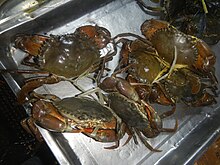| Scylla olivacea | |
|---|---|

| |
| Scylla olivacea from the Philippines | |
| Scientific classification | |
| Domain: | Eukaryota |
| Kingdom: | Animalia |
| Phylum: | Arthropoda |
| Class: | Malacostraca |
| Order: | Decapoda |
| Suborder: | Pleocyemata |
| Infraorder: | Brachyura |
| Family: | Portunidae |
| Genus: | Scylla |
| Species: | S. olivacea |
| Binomial name | |
| Scylla olivacea (Herbst, 1796) | |
Scylla olivacea, commonly known as the orange mud crab, is a commercially important species of mangrove crab in the genus Scylla. It is one of several crabs known as the mud crab and is found in mangrove areas from Southeast Asia to Pakistan, and from Japan to northern Australia. Along with other species in the genus Scylla, it is widely farmed in aquaculture using wild-caught stocks. They can be differentiated from other species of Scylla by having blunted spines on the dorsal distal corner of the palm (propodus) of the claw, and by the rounded frontal lobe spines with shallow separations in between the eyes.
References
- Keenan, Clive P.; Davie, Peter J.F.; Mann, David L. (1998). "A revision of the genus Scylla de Haan, 1833 (Crustacea: Decapoda: Brachyura: Portunidae)". The Raffles Bulletin of Zoology. 46 (1): 217–245.
- Fazhan, Hanafiah; Waiho, Khor; Ikhwanuddin, Mhd (2017). "Non-indigenous giant mud crab, Scylla serrata (Forskål, 1775) (Crustacea: Brachyura: Portunidae) in Malaysian coastal waters: a call for caution". Marine Biodiversity Records. 10 (26).
| Taxon identifiers | |
|---|---|
| Scylla olivacea | |
This Portunoidea article is a stub. You can help Misplaced Pages by expanding it. |